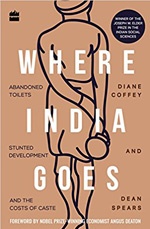Around the world, people live healthier lives than in centuries past, in part because latrines keep faecal germs away from growing babies. India is an exception. Most Indians do not use toilets or latrines, and so infants in India are more likely to die than in neighbouring poorer countries. Children in India are more likely to be stunted than children in sub-Saharan Africa.
Where India Goes demonstrates that open defecation in India is not the result of poverty but a direct consequence of the caste system, untouchability and ritual purity. Coffey and Spears tell an unsanitized story of an unsanitary subject, with characters spanning the worlds of mothers and babies living in villages to local government implementers, senior government policymakers and international development professionals. They write of increased funding and ever more unused latrines.
This is an important and timely book that calls for the annihilation of caste and attendant prejudices, and a fundamental shift in policy perspectives to effect a crucial, much overdue change.










